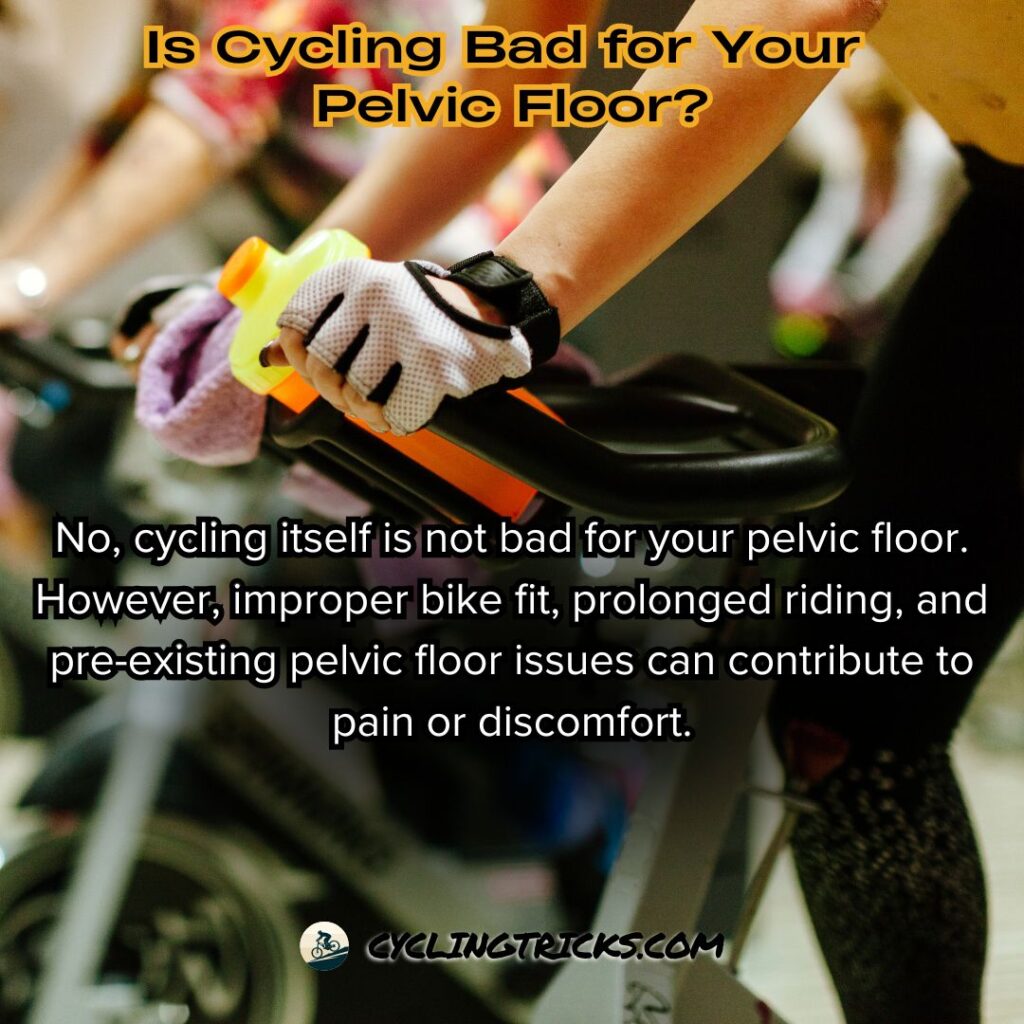Did you know that a surprising 61% of female cyclists experience some form of pelvic floor dysfunction?
When it comes to cycling and pelvic floor health, many misconceptions and concerns have arisen. People wonder if the repetitive motion and impact of cycling can lead to pelvic floor issues such as incontinence or pelvic organ prolapse.
However, the relationship between cycling and the pelvic floor is more complex than it seems.
In this article, I will debunk common myths, provide safe riding tips, and explore the relationship between cycling and pelvic floor health.
Whether you’re a seasoned cyclist or a beginner, understanding and taking care of your pelvic floor is crucial for a comfortable and enjoyable ride.
Key Takeaways:
- 61% of female cyclists experience some form of pelvic floor dysfunction.
- The relationship between cycling and the pelvic floor is complex.
- Understanding and taking care of your pelvic floor is crucial for a comfortable and enjoyable ride.
Is Cycling Bad for Your Pelvic Floor?
No, cycling itself is not bad for your pelvic floor. However, improper bike fit, prolonged riding, and pre-existing pelvic floor issues can contribute to pain or discomfort.
For safe and enjoyable cycling, prioritize proper bike fit, listen to your body, and consider seeking professional advice if you experience any pelvic pain.

Understanding Pelvic Floor Dysfunction
When it comes to cycling, it’s essential to have a clear understanding of pelvic floor dysfunction and how it can be influenced by this activity. Pelvic floor dysfunction refers to a range of conditions that affect the muscles, ligaments, and connective tissues in the pelvic floor region.
While cycling is a fantastic form of exercise with numerous benefits, it can also pose challenges to the pelvic floor and potentially exacerbate existing problems.
Individuals who have pelvic floor dysfunction may experience a range of symptoms while cycling. These symptoms can include urinary incontinence, pelvic pain, pelvic organ prolapse, and se*ual dysfunction. It’s important to recognize and address these symptoms to ensure a comfortable and enjoyable cycling experience.
Certain factors related to cycling, such as sustained pressure on the pelvic floor, repetitive motion, and poor bike fit, can contribute to pelvic floor problems.
Cycling requires a significant engagement of the lower body muscles, and repetitive pedaling motions can put strain on the pelvic floor. Additionally, an improper bike fit that places excessive pressure on the perineum can exacerbate symptoms of pelvic floor dysfunction.
It’s vital to have a comprehensive understanding of pelvic floor health and be aware of the potential challenges associated with cycling. By acknowledging these issues and implementing appropriate strategies, individuals can manage and mitigate the impact of cycling on their pelvic floor.
In the following sections, we will explore the relationship between cycling and pelvic floor health and provide helpful tips to promote a safe and enjoyable riding experience while minimizing the risk of pelvic floor issues.
The Relationship Between Cycling and Pelvic Floor Health
When it comes to cycling and pelvic floor health, there is a fascinating interplay between the two. Cycling can offer various benefits for the pelvic floor, while also posing some challenges that need to be managed effectively.
In this section, we will explore the relationship between cycling and pelvic floor health, and provide valuable insights on how to maintain a healthy pelvic floor while enjoying the sport.
The Benefits of Cycling for Pelvic Floor Health
Cycling, as a low-impact cardiovascular exercise, can be beneficial for the pelvic floor muscles.
Regular cycling can help improve blood circulation, strengthen muscles in the pelvic region, and enhance overall pelvic floor health. Engaging in moderate-intensity cycling can also help to build endurance and support healthy bladder and bowel function.
However, it is essential to note that excessive cycling, especially in combination with poor bike fit or improper posture, can potentially lead to pelvic floor dysfunction. That’s why it’s crucial to balance your cycling routine with pelvic floor exercises and appropriate strategies to optimize your overall pelvic floor health.
Managing Pelvic Floor Health While Cycling
To effectively manage pelvic floor health while cycling, incorporating pelvic floor exercises into your routine is key. These exercises can target and strengthen the pelvic floor muscles, improving their function and reducing the risk of pelvic floor issues.
Some recommended pelvic floor exercises for cyclists include:
- Pelvic floor contractions: Also known as Kegel exercises, these involve tightening and relaxing the pelvic floor muscles in a controlled manner. They can be performed at any time, even during cycling, as they do not require specific equipment.
- Bridges: Lie on your back with knees bent and feet flat on the ground. Lift your hips off the floor, engaging your glutes and pelvic floor muscles. Hold for a few seconds and then lower your hips. Repeat the exercise for a set of repetitions.
- Squats: Stand with feet shoulder-width apart, lower yourself into a squatting position while keeping your back straight and your weight on your heels. Engage your core and pelvic floor muscles throughout the exercise. Rise back up to the starting position and repeat.
It’s essential to consult with a pelvic health specialist or physical therapist to ensure you are performing the exercises correctly and to tailor them to your specific needs.
In addition to exercises, there are other strategies to consider for maintaining pelvic floor health while cycling. These include:
- Investing in a bike fitting session to ensure proper saddle height and position, which can reduce stress on the pelvic floor.
- Using padded cycling shorts or a cushioned saddle to provide additional support and minimize pressure on the pelvic area.
- Taking regular breaks during long rides to stretch, relax, and allow the pelvic floor muscles to recover.
The Importance of Balance
It’s important to strike a balance between your love for cycling and maintaining pelvic floor health. By incorporating pelvic floor exercises, implementing proper bike fit and posture, and adopting strategies to minimize pressure on the pelvic floor, you can enjoy the benefits of cycling while safeguarding your pelvic floor health.
| Exercise | How to Perform | Repetitions |
|---|---|---|
| Pelvic Floor Contractions (Kegel Exercises) | Tighten and relax pelvic floor muscles | 3 sets of 10 repetitions |
| Bridges | Lift hips off the floor while engaging glutes and pelvic floor muscles | 3 sets of 12 repetitions |
| Squats | Lower into a squatting position while engaging core and pelvic floor muscles | 3 sets of 15 repetitions |
Preventing Pelvic Floor Damage While Cycling
Cycling is a great form of exercise that offers numerous benefits for overall health and fitness. However, it’s important to be aware of the potential impact cycling can have on your pelvic floor.
To prevent pelvic floor damage and minimize the risk of issues, here are some practical tips and techniques to keep in mind:
Proper Bike Fit
Ensuring that your bike is properly fitted to your body can significantly reduce the strain on your pelvic floor. Consider getting a professional bike fitting to ensure that the seat height, position, and handlebar reach are appropriate for your unique body proportions.
Posture Matters
Maintaining good posture while cycling is crucial for protecting your pelvic floor. Avoid slouching or rounding your back, as this can put unnecessary pressure on the pelvic area. Instead, try to keep a neutral spine and engage your core muscles to provide support.
Engage Your Glutes
Strong glute muscles can help to stabilize and support your pelvic floor while cycling. Make a conscious effort to engage your glutes during your rides by squeezing your buttocks and focusing on the muscles in that area. This can help prevent excessive strain on the pelvic floor.
Listen to Your Body
Your body is a great indicator of whether or not you’re putting too much pressure on your pelvic floor while cycling. If you experience any discomfort, pain, or a feeling of heaviness in the pelvic area, it’s important to take a break and allow your body to rest. Pushing through these symptoms can potentially lead to more serious issues.
Include Pelvic Floor Exercises
Specific exercises that target and strengthen the pelvic floor muscles can be extremely beneficial for preventing pelvic floor issues from cycling. Incorporate exercises such as Kegels or pelvic floor bridges into your regular fitness routine to provide additional support and resilience to your pelvic floor.
By following these tips and techniques, you can enjoy the many benefits of cycling while minimizing the risk of pelvic floor damage or issues. Remember to always listen to your body, prioritize proper bike fit and posture, and incorporate pelvic floor exercises into your routine to maintain a healthy and strong pelvic floor.
Pelvic Floor Rehabilitation for Cyclists
For cyclists who have experienced pelvic floor issues, rehabilitation is essential for recovery and strengthening of the pelvic floor muscles. Through various treatment options and targeted exercises, cyclists can regain control and alleviate any discomfort or pain associated with pelvic floor dysfunction.
One effective form of pelvic floor rehabilitation for cyclists is pelvic floor physical therapy. During these sessions, a trained therapist will guide you through exercises that specifically target the pelvic floor muscles. These exercises help improve muscle tone, flexibility, and overall pelvic floor function.
In addition to physical therapy, incorporating pelvic floor exercises into your daily routine can further aid in rehabilitation. These exercises typically involve contracting and relaxing the pelvic floor muscles to build strength and improve blood flow in the area. Some commonly recommended pelvic floor exercises for cyclists include:
- Pelvic floor contractions: Squeeze the muscles in your pelvic floor as if you were trying to stop the flow of urine. Hold for a few seconds, then release. Repeat this exercise multiple times throughout the day.
- Bridge exercise: Lie on your back with your knees bent and feet flat on the floor. Lift your hips off the ground, engaging your glutes and pelvic floor muscles. Hold for a few seconds, then lower back down. Repeat for several repetitions.
- Deep breathing exercises: Focus on deep, diaphragmatic breathing while contracting and releasing the pelvic floor muscles. This helps improve coordination and relaxation of the pelvic floor.
It’s important to gradually increase the intensity and duration of pelvic floor exercises to avoid straining the muscles. Consult with a healthcare professional or pelvic floor specialist to create a personalized rehabilitation plan tailored to your specific needs.
“Pelvic floor rehabilitation is crucial for cyclists who want to recover from pelvic floor issues and improve their overall pelvic floor health. By incorporating targeted exercises and seeking professional guidance, cyclists can effectively rehabilitate their pelvic floor and get back to enjoying their rides.” – Dr. Emily Thompson, Pelvic Floor Specialist
Remember, consistency is key when it comes to pelvic floor rehabilitation. Stick to your personalized exercise routine and stay dedicated to your recovery journey. With time and proper care, you can regain strength and function in your pelvic floor, allowing you to continue cycling safely and comfortably.
Safe Riding Tips for Optimal Pelvic Floor Health
When it comes to managing pelvic floor health while cycling, there are several important tips to keep in mind.
By following these guidelines, riders can reduce the risk of pelvic floor issues and ensure a safe and comfortable cycling experience.
Proper Bike Fit
Ensuring your bike is properly fitted to your body is essential for maintaining pelvic floor health while cycling.
A bike that is too high or too low can put unnecessary pressure on the pelvic floor, leading to discomfort and potential issues. Consult with a professional bike fitter to ensure your bike is adjusted to the appropriate saddle height, reach, and handlebar position for your body.
Pelvic Floor Exercises
One of the most effective ways to manage pelvic floor health while cycling is by incorporating targeted exercises into your routine.
Strengthening the pelvic floor muscles can provide support and stability, reducing the risk of pelvic floor issues. Consider including exercises like Kegels, bridges, and squats in your regular workout regimen to help maintain pelvic floor strength.
Proper Posture
Maintaining proper posture while riding is crucial for pelvic floor health.
Slouching or leaning too far forward can increase pressure on the pelvic floor, potentially leading to discomfort. Focus on sitting upright with a neutral spine and engaging your core during your rides.
Regular Breaks
Taking regular breaks during long rides can help alleviate pressure on the pelvic floor.
Giving your body a chance to rest and recover can reduce the risk of developing pelvic floor issues. Aim to take short breaks every hour or so, allowing yourself time to stretch, move around, and relieve any potential pressure points.
Comfortable Saddle
The saddle you choose can significantly impact your pelvic floor health while cycling.
Opt for a saddle that provides adequate support and cushioning, and consider getting professionally fitted for a saddle if needed.
Experimenting with different saddle shapes and materials can help you find the one that offers the most comfort and reduces pressure on your pelvic floor.
Listen to Your Body
Finally, it’s important to listen to your body and address any discomfort or pain immediately.
If you experience any pelvic floor issues while cycling, such as pain, numbness, or incontinence, consult with a healthcare professional who specializes in pelvic floor health.
They can provide guidance, treatment options, and further recommendations to help you manage your pelvic floor health while enjoying your rides.
Suggested Table (Safe Riding Tips for Optimal Pelvic Floor Health)
| Tips | Key Actions |
|---|---|
| Proper Bike Fit | Consult a professional bike fitter to ensure correct saddle height, reach, and handlebar position. |
| Pelvic Floor Exercises | Incorporate targeted exercises like Kegels, bridges, and squats into your regular workout routine. |
| Proper Posture | Maintain an upright position with a neutral spine and engaged core during rides. |
| Regular Breaks | Take short breaks every hour or so to stretch, move around, and relieve pressure on the pelvic floor. |
| Comfortable Saddle | Choose a saddle that offers adequate support and cushioning, and consider professional fitting if necessary. |
| Listen to Your Body | Address any discomfort or pain immediately and seek guidance from a healthcare professional specializing in pelvic floor health. |
Conclusion
Throughout this article, we have explored the relationship between cycling and pelvic floor health, debunking common myths and providing valuable insights. It is crucial to understand how cycling can potentially impact the pelvic floor and take necessary precautions to ensure a safe and enjoyable ride.
By practicing proper bike fit, maintaining good posture, and incorporating targeted exercises, cyclists can minimize the risk of pelvic floor dysfunction. These proactive measures can help prevent pelvic floor damage and promote overall pelvic floor health.
Remember, your pelvic floor plays a vital role in supporting your body during cycling, and taking care of it should be a priority. So, whether you are a seasoned cyclist or a beginner, make sure to prioritize your pelvic floor health to maximize your riding experience and minimize any potential issues.








